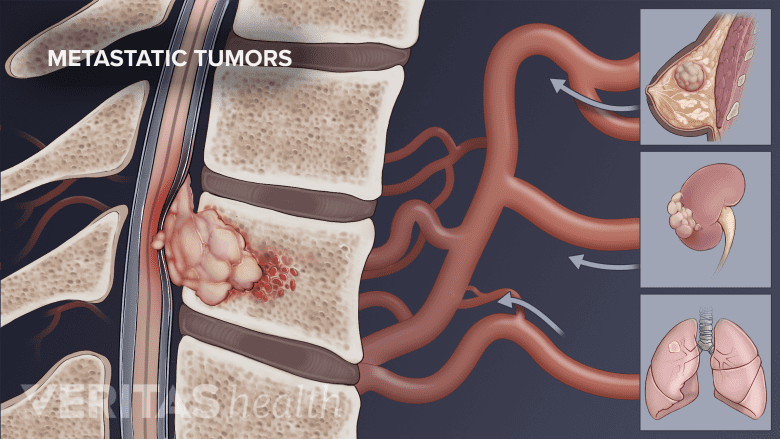A computed tomography scan, commonly referred to as a CT scan, is a radiological imaging technique that creates two-dimensional images of the body in horizontal and cross-sectional (sliced) planes.
For neck and/or spinal conditions, CT is often a first-line imaging study for detecting and characterizing infections, tumors, traumatic injuries, and skeletal disorders.,
In This Article:
Spinal Conditions That May Be Identified on a CT Scan

CT scans provide precise images for diagnosing spinal tumors.
A spinal CT scan can show details of bones, muscles, and organs, and aid in the diagnosis of neck or back pain from:
- Vertebral fractures
- Spinal degenerative changes
- Vertebral instability
- Spinal osteomyelitis
- Spinal tumors and masses
A CT procedure can allow the entire cervical (neck) spine or the whole spine to be adequately visualized, and this type of view is typically preferred in the emergency department to examine traumatic injuries in detail. CT is the imaging technique of choice for gunshot wounds, providing clear details of the injury, which cannot be seen in other specialized scans, such as a magnetic resonance imaging (MRI) scan, due to the metallic nature of the bullet.
Computed tomography may not adequately capture tendons, ligaments, spinal cord, or intervertebral discs, making conditions related to these structures less visible on a CT scan.
Read more about Spinal Anatomy and Back Pain
How a CT Scan Works
Computed tomography is essentially an x-ray study, where a series of x-rays are rotated in different directions around a specific body part, producing a sequence of computer-generated images. These sequential images are not superimposed, in contrast to conventional x-rays, providing excellent details of the target tissue(s).
The x-ray information is sent to a computer that gathers the data and displays it as a series of two-dimensional images on a monitor.
Intraoperative CT

CT scans guide spinal fusion surgeries for precise hardware placement and fusion evaluation.
An intraoperative CT scan is used in neurosurgery to provide real-time images during a surgical procedure or immediately after the surgery is done. Using intraoperative CT allows the surgery to be minimally invasive, preventing extensive and open surgical procedures.
For spinal fusion surgeries, intraoperative CT assists in accurate screw placement.
Preparing for a Spinal CT
Jewelry, clothing and accessories that contain metal, and surgical clips can cause artifacts on a CT scan, obscuring the images. A hospital gown is provided, and patients are instructed to remove all jewelry before the scan. A CT scan does not affect the device setting of pacemakers and programmable pumps or shunts and can be used safely for patients who have these devices.
Spinal CT Procedure
A spinal CT is a painless procedure and is taken in a hospital equipped with a CT machine. Neck and back CT scans follow the same process, which typically involves the following steps:
- The patient lies on a scan table with pillows and straps to minimize or prevent bodily movement.
- Once the patient is comfortable, the technician leaves the room and controls the CT machine from an adjoining room.
- The scan table slides into a large circular-shaped opening of the CT machine and the scanner begins to rotate around the scan table.
- The x-ray beams that are emitted by the machine and absorbed by the body are detected by the scanner, which transmits it in the form of an image to be viewed on a computer.
Some types of CT studies, such as CT with myelogram, need a contrast dye to be injected prior to the scan. The dye helps illuminate the nervous tissues of the spine for better contrast in addition to the high CT resolution.
Risks of Spinal CT
The CT procedure has the potential to cause harm to body tissues due to exposure to ionizing radiation. Computed tomography uses 50 to 1000 times higher radiation dose than conventional x-rays and comprises approximately 50% of all medical radiation.
The test is generally not recommended for pregnant women unless the benefit of the scan outweighs the potential risk of tissue damage in the fetus. A CT scan is also not recommended in children under 10 years of age due to the potential tissue damage to the developing organs from radiation exposure.
CT scans are valuable resources in diagnosing several neck and back conditions and can be used before, during, and after spinal treatments. The benefits of the scan typically outweigh the risk of the amount of radiation exposure. CT should be used sparingly or other diagnostic methods, such as MRI, should be considered when the risk of radiation exposure and tissue damage is high.
Read more about Getting an Accurate Back Pain Diagnosis

